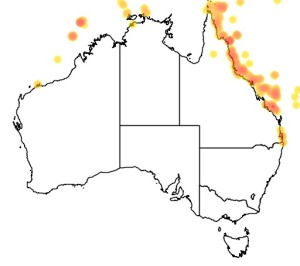Colours
Distinguishing features
A small yellow-beige damselfish with a distinct ocellus on the rear of the dorsal fin, except in the largest sizes. Similar to Pomacentrus moluccensis, but the latter lacks an ocellus and the body colour is a deeper yellow. Distinguish also based on preferred habitat type.
Size
- Up to 10 cm (Standard length)
Depth range
- Depth range data is not yet available.
Synonyms
Similar taxa
-
Animalia:
Lemon Damsel (species: Pomacentrus moluccensis)
is brighter yellow, never has an ocellus, and lives among live coral rather than at the sand/reef edge.
Distribution
Distribution and habitat preferences
Reef borders with sandy margins, in both shallow lagoonal and backreef areas as well as exposed reef fronts.
Found in most locations around the Island.
Behaviour
The Ambon Damsel is common at Lizard Island, and is often the dominant small damselfish in the lagoonal areas where reef and sand habitat adjoin. Once onto the reef proper, the Ambon Damsel is replaced by the Lemon Damsel. This species is an omnivore, taking both plankton and algae. It has been widely used as a study animal in reef fish ecology research on the GBR, especially in the area of reproduction, larval dispersal, and recruitment.
Web resources
References
References that assist with identification
- Streit, R.P. and D.R. Bellwood (2017). High prevalence of homing behaviour among juvenile coral-reef fishes and the role of body size, Coral Reefs, 36(4): 1083-1095. LIRS catalog number 2091.
Other references
- Couturier, C.S., J.A.W. Stecyk, J.L. Rummer, P.L. Munday and G.E. Nilsson (2013). Species-specific effects of near-future CO2 on the respiratory performance of two tropical prey fish and their predator. Comparative Biochemistry and Physiology, Part A, 166: 482-489. LIRS catalog number 1721.
- Gagliano, M. and M.I. McCormick (2007). Maternal condition influences phenotypic selection on offspring, Journal of Animal Ecology, 76: 174-182. 76 Journal of Animal Ecology, 76: 174-182. LIRS catalog number 1027.
- View all references




